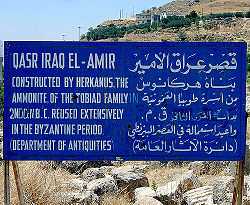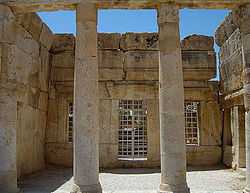Qasr al Abd
Qasr al Abd is a large ruin in western Jordan dating from approximately 200BC, and standing in the valley of Wadi Seer, approximately 17 kilometres west of Amman, close to the village of `Iraq al Amir.
History

Although little is known for definite about the history of Qasr al-Abd it is widely believed to have been built by a Tobiad notable, Hyrcanus of Jerusalem, head of the powerful Tobiad family and governor of Ammon. Credence for this theory is gained from the fact that the Hebrew name 'Tuvya' or 'Toviyya' (Tobias) is engraved (טוביה but in a more Aramaic script) above the adjacent burial caves of Iraq al Amir (which share their name with the nearby village). In another of these caves there is a carving of a lioness sheltering a cub at the palace.
According to a local legend, Tobiad was a commoner who fell in love with the daughter of a nobleman. When he asked for her hand in marriage, the nobleman said that Tobiad could only have her hand if he built the so-called "Castle of the Slave." After completing the castle, the nobleman had Tobiad killed as he did not want his daughter marrying a commoner.
It is known that the structure was originally surrounded by a large excavated reflecting pool, leading the first-century AD Jewish historian Flavius Josephus to suppose that this was a moat and the building a fortress. However, more recent evidence for the building's original function being as a country pleasure palace has been presented by the contemporary Israeli archaeologist Ehud Netzer. It has also been suggested that the site was in fact intended to serve as a mausoleum of the Tobias family, although it was never completed.[1]
The name Qasr al Abd can be translated as Castle of the Slave or Servant, a title which may refer to Hyrcanus himself, who, as governor, was a "slave of the people". The biblical Book of Nehemiah mentions "Toviyya, the Servant, the Ammonite" (2:10). According to Josephus, Hyrcanus left Jerusalem after losing a power struggle, and established his residence east of the Jordan, apparently on the ancestral lands of the Tobiad dynasty. The area was then a border zone between Judea and Arabia, and Josephus mentions that Hyrcanus was in constant skirmishes with Arabians, killing and capturing many. He took his own life in 175 BC, following the ascent to power in Syria of the strongly anti-Jewish Seleucid king Antiochus Epiphanes, fearing the latter's revenge for his fights with the Arabians. The villa was unfinished at the time of his death (as indicated by several incomplete carvings and columns on site), and was seized by Antiochus Epiphanes. Josephus mentions the "beasts of gigantic size carved on it" (Antiquities of the Jews, Book XII, 230), and carved tigers or lions are still perfectly preserved on the remains visible today.
The palace was badly damaged by a great earthquake that hit the region in 362 AD.
Architecture

The heavily decorated two-storey stone structure (measuring about 40 metres by 20 metres, and 13 metres high) is a rare example of Hellenistic architecture in Jordan. In the 1st century AD, Flavius Josephus described it as, "A strong fortress, which was constructed entirely of white marble up to the very roof and had beasts of gigantic size carved on it; and he enclosed it with a wide and deep moat". The castle is built from some of the largest single blocks of any building in the Middle East, with the largest block measuring seven by three metres. However, these blocks were at most only 40 centimetres wide (making the building relatively vulnerable to the earthquake which destroyed it).
Archaeologists have established that Qasr al-Abd once stood in a much larger estate which was originally surrounded by a wall and included a park with trees and shrubs (a large stone olive press has been found on the site, suggesting the estate was partially self-sufficient in agricultural produce). Much of the estate now stands beneath the village of Iraq al-Amir.
Restoration
The ruins of Qasr al-Abd have been partially restored, due to the efforts of a French team directed by Ernest Will and the architect François Larché in collaboration with Fawzi Zayadine of the Jordanian Archaeological Service.[2] The team spent the years 1979 to 1985 making detailed drawings of the fallen stones and on the subsequent reconstruction.
References
Iraq al-Amir, le château du Tobiade Hyrcan par E. Will et F. Larché, volume I, BAH, T. CXXXII, 1991.
Iraq al-Amir : le château du Tobiade Hyrcan. Volume II, Restitution et reconstruction, par F. Larché, contributions de F. Braemer et de B. Geyer, IFPO, Beyrouth 2005, 2 vol. BAH, T. 172.
'Iraq al-Amir, guide historique et archéologique du domaine des Tobiades. Beyrouth, Guides archéologiques de l’Ifpo, 2010.
External links
http://www.dailymotion.com/video/xilpij_jordanie-iraq-al-emir-le-reve-inacheve-1-2_webcam